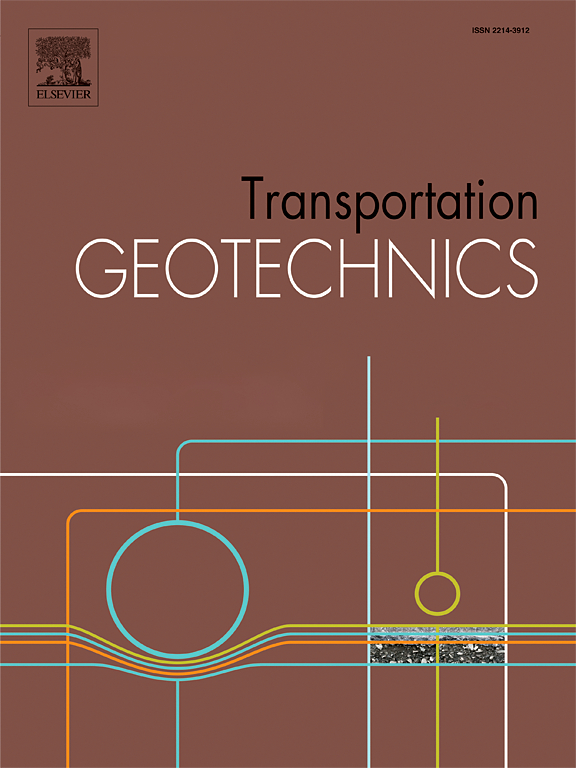Particle Geometry Space: An integrated characterization of particle shape, surface area, volume, specific surface, and size distribution
IF 4.9
2区 工程技术
Q1 ENGINEERING, CIVIL
引用次数: 0
Abstract
Particle size and shape are the two key 3D particle geometry parameters that govern the complex behavior of granular materials. The effect of particle size and shape has often been examined in isolation, typically through separate analyses of particle size distribution (PSD) and shape distribution, leading to an unaddressed knowledge gap. Beyond size and shape, 3D particle geometry also includes attributes such as surface area and volume, which together defines the surface-area-to-volume ratio, commonly known as the specific surface. To comprehensively understand the influence of particle geometry on the behavior of granular materials, it is important to integrate these parameters, ideally into a single analytical framework. To this end, this paper presents a new approach, particle geometry space (PGS), formulated based on the principle that the key 3D particle geometry attributes – volume, surface area, and shape – can be uniformly expressed as a function of specific surface. The PGS not only encompasses all 3D particle geometry attributes but also extends its scope by integrating the conventional PSD concept. This innovation enables engineers and researchers who are already familiar with PSD to perform a more systematic characterization of 3D particle geometries. The paper (i) discusses the limitations of existing methods for characterizing 3D particle geometry, (ii) offers an overview of the PGS, (iii) proposes a method for integrating PSD into the PGS, and (iv) demonstrates its application with a set of 3D mineral particle geometry data.
粒子几何空间:粒子形状、表面积、体积、比表面积和尺寸分布的综合表征
颗粒尺寸和形状是控制颗粒材料复杂行为的两个关键三维颗粒几何参数。粒径和形状的影响通常是单独研究的,通常是通过对粒径分布(PSD)和形状分布的单独分析,这导致了一个未解决的知识空白。除了尺寸和形状,3D粒子几何还包括表面积和体积等属性,它们共同定义了表面积与体积比,即通常所说的比表面。为了全面了解颗粒几何形状对颗粒材料行为的影响,将这些参数整合到一个理想的分析框架中是很重要的。为此,本文提出了一种新的方法——粒子几何空间(PGS),该方法基于关键的三维粒子几何属性——体积、表面积和形状——可以统一表示为比表面的函数的原理。PGS不仅包含了所有的3D粒子几何属性,而且通过整合传统的PSD概念扩展了它的范围。这项创新使已经熟悉PSD的工程师和研究人员能够更系统地表征3D粒子几何形状。本文(i)讨论了现有3D粒子几何特征方法的局限性,(ii)概述了PGS, (iii)提出了一种将PSD集成到PGS中的方法,(iv)通过一组3D矿物粒子几何数据演示了其应用。
本文章由计算机程序翻译,如有差异,请以英文原文为准。
求助全文
约1分钟内获得全文
求助全文
来源期刊

Transportation Geotechnics
Social Sciences-Transportation
CiteScore
8.10
自引率
11.30%
发文量
194
审稿时长
51 days
期刊介绍:
Transportation Geotechnics is a journal dedicated to publishing high-quality, theoretical, and applied papers that cover all facets of geotechnics for transportation infrastructure such as roads, highways, railways, underground railways, airfields, and waterways. The journal places a special emphasis on case studies that present original work relevant to the sustainable construction of transportation infrastructure. The scope of topics it addresses includes the geotechnical properties of geomaterials for sustainable and rational design and construction, the behavior of compacted and stabilized geomaterials, the use of geosynthetics and reinforcement in constructed layers and interlayers, ground improvement and slope stability for transportation infrastructures, compaction technology and management, maintenance technology, the impact of climate, embankments for highways and high-speed trains, transition zones, dredging, underwater geotechnics for infrastructure purposes, and the modeling of multi-layered structures and supporting ground under dynamic and repeated loads.
 求助内容:
求助内容: 应助结果提醒方式:
应助结果提醒方式:


